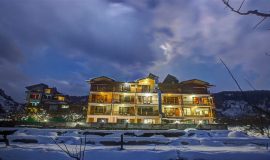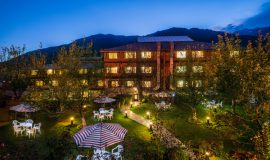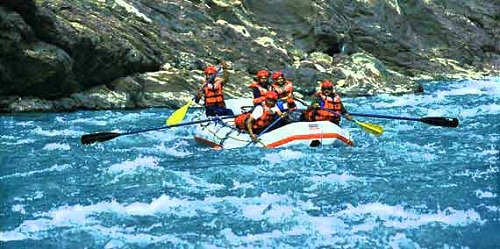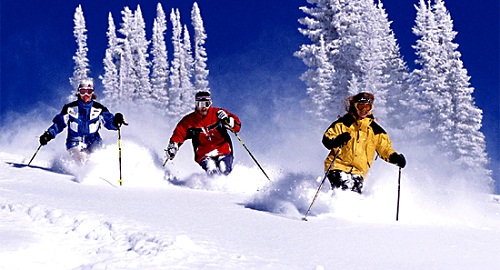
Accommodations


Hotel Snow Villa

Himalayan Paradise

Hotel Mountain Face

Wood Valley Cottages

Hotel Ashoka Inn

Hotel Ridge View

Hotel Snow Bird

Anant Maya Resorts

Honeymoon Inn Manali
Tours
Things to Do

Adventure Activities
Around Manali, there are plentiful open doors for experience sports. The Mountaineering Institute in Manali is bolstered by the Himachal Tourism and composes courses in skiing, rock climbing and mountaineering.The Institute and the traveler office, alongside private visit administrators like the Himalayan Saga and SAHSI, Start Adventure Himalayan Sports Institute, compose treks from Manali to other adjacent spots. The best season to for these audacious exercises is after the downpours from mid-September till end of October. The trek courses are burdensome and can be deceptive, so make certain to have all around prepared aides notwithstanding the customary maps. You can make a beeline for the slants at the Solang nala, Patalsu, Kothi, Marhi, and Rohtang Pass which have been created for skiing. At Rohtang and Patalsu, skiing should likewise be possible in summer
Trekking

Many Trekking Routes are available in Manali. Major treks in manali are Beas Kund Trek, Bhrigu Lake Trek, Chandrakhani Trek, Chandra Taal Trek and many more. The check list of the equipments required for trekking in manali includes of Comfortable walking shoes with a good grip on the ankles. Water proof warm jacket.Woolen / tennis scocks and stockings. Sunglasses, headgear, rucksack and other bags too if you plan to hire porters and ponies. Water- Bottle, Swiss army Knife, Sleeping Bag and foam ground sheet, Gloves, umbrella, rope, Medical and first aid equipment.Manali is a paradise for trekking enthusiasts. High altitude treks from Manali offers breath taking vistas and panoramic views of the Himalayas. The season for low altitude trek in Manali starts in April and the high altitude trek season spans the months of June to October. Manali is also the base to Lahaul & Spiti, Leh Ladakh and Zanskar almost revered by ardent trekkers .The main trekking areas in Himachal are the Dhauladhar and Pir Panjal ranges, routes over the passes between the Shimla region and the Kullu valley, the numerous treks out of kullu and select tracks in the Trans-Himalayan regions of Kinnaur, Lahaul and Spiti. Most trekking areas are between 1,500 meters and 6,000 meters. With well over two hundred and seventy defined trails, the variation in terrain is also enormous. Low scrub-land and paths through paddy fields, give way to trails strewn with pine needles. Then come woods of oak and flowering rhododendron, which merge into forests of Himalayan cedar – ‘deodar’ – and spruce. On most trails, small pastoral hamlets dot the way. Cunningly hidden between the high mountains, are passes which were once known only to migrant shepherds and dare-all traders.
Rafting

Stream rafting in manali is offered by private heads at Pirdi close Kullu where a water sports center has beenset up to give the rafting organizations in manali for the explorers. Rafting in manali is open on stretches out of the River Beas, where rapids of high assessments can be masterminded. Rafting in kullu manali gives an exciting interlude fro enthusiasts. kayaking is possible at Pandoh Dam while in travel to Mandi. Water rafting in Kullu manali is done on stream Beas from Pirdi (4 kms before Kullu town) down to Jhiri, on a stretch of around 14 kms.(Period Apr fifteenth Jun end). The trek takes just about one and half hour including rapids from assessment II and III.Rafting in Kullu Manali begins at around 10 o’ check in the morning at Pirdi. Pirdi is 45 kms from Manali and in this way, recommended starting time from Manali is 8 o’clock. This activity will require one whole day.
Skiing

Close Manali there are a few slants, which have been evaluated the best to ski on the planet. The Solang Nullah, Patalsu, Kothi, Marhi and Rohtang inclines are useful for skiing in the winters and in addition in summers. Actually Patalsu and Rohtang inclines are the main spots where one can do summer skiing. The inclines are by and large further created to suit more students and travelers.
The national level skiing rivalry is hung on the slants of Solang Nullah and the winter jamboree is sorted out at Manali. The spot can possibly offer some world-class ski slants. There are private associations that give preparing and in addition hardware for skiing. The Mountaineering Institute has set up a little ski lift at Solang Nullah.Riding the thermals and cruising the blue sky like the Himalyan Eagle can excite experience. Paragliding offices are accessible at Solang Nallah and Marhi. Traveler are encouraged to embrace the game just through the administrators who are enlisted with the Tourism Department. Likewise demand the pilot demonstrating to you his enlistment permit issued by the District Administration.
Paragliding

Riding the thermals and cruising the blue sky like the Himalyan Eagle can excite experience. Paragliding offices are accessible at Solang Nallah and Marhi. Traveler are encouraged to embrace the game just through the administrators who are enrolled with the Tourism Department. Likewise demand the pilot demonstrating to you his enlistment permit issued by the District Administration. Paragliding is sorted out in Kullu valley during the time at Solang Valley, found 14 kms from Manali and different areas like Marhi, Fatru, Bijli Mahadev and so forth. There are by and large two sort of flights:1. Short flights : The customer is taken 100 – 150 mts up the slant and brings a flight alongside the pilot in the
two seater paraglider. The flight goes on for roughly 60 – 90 seconds.2. High flying : Approximately 20-30 minutes flight and masterminded at Fatru, Kothi and Bijli Mahadev. Fundamentally for experienced pilots who have done short flights. Paragliding choices for apprentices begin from an unsuitable 1 minute bounce to a charming 20 minute flight. Paragliding Charges One moment short flight : Rs.500 – 700 Twenty minutes flight : Rs. 1,800 note: Go with trained pilots for Paragliding. Book from a good adventure tour operator based at Manali and insist that charge should include to and fro trip to Solang Valley.Paragliding is banned during monsoons (July to September)
Great Himalayan National Park
The Great Himalayan National Park (GHNP) is located in the Kullu District of Himachal Pradesh, India. Initially constituted in 1984, GHNP was formally declared a National Park in 1999, covering an area of 754.4 sq kms. In 1994, two major changes were made in land use around the Park. A buffer zone of 5 km from the Park’s western boundary, covering 265.6 sq km. and including 2,300 households in 160 villages, was delineated as an Ecozone. Most of the population (about 15,000 to 16,000 people) in the Ecozone are poor and dependent on natural resources for their livelihoods
The second change was the creation of the Sainj Wildlife Sanctuary (90 sq km) around the three villages of Shagwar, Shakti, and Marore. On the southern edge of the GHNP, another Protected Area (PA) was declared, known as Tirthan Wildlife Sanctuary. This covers 65 sq km and is without habitation. More recently, in 2010, both the Sainj and Tirthan Wildlife Sanctuaries were added to GHNP, but will not be formally incorporated until a process known as settlement of rights has occurred. Thus the initiated merger of Sainj and Tirthan Wildlife Sanctuaries with GHNP will be followed by a process of settlement to relocate inhabitants and make the area free of traditional pressures, which may take some time. The total area under Park administration (National Park, Wildlife Sanctuaries and Ecozone) is 1171 sq km, which is together referred to as the Great Himalayan National Park Conservation Area (GHNPCA).
In 2010, an area of 710 sq km of the Parvati river catchment contiguous to the northern boundary of GHNP was initially notified as the Khirganga National Park, adding significant biological diversity, conservation value, and physical protection to GHNP. The boundaries of GHNP are also contiguous with the Pin Valley National Park (675 sq km) in Trans-Himalaya, the Rupi Bhabha Wildlife Sanctuary (503 sq km) in Sutlej watershed and the Kanawar Wildlife Sanctuary (61 sq km), adding additional protection and conservation value and opening up extended wildlife corridors.
MORE
Manikaran
Manikaran is a famous pilgrimage place situated in Kullu district of Himachal Pradesh State. This place is famous for Shiva temple, Ram temple, Gurudwar and hot water springs. Manikaran is in Parbati (Parvati)valley. Parvati valley is the largest valley in Kullu district of Himachal Pradesh state in India covering 90Kms length and 1085 sq.Km area. The Himalayan range of hills at Manikaran are called Shivalik range. The Parvati river flows beside the Shiva temple and Gurudwara. The starting point of Parvati river is at Mantalai. Many hot water springs are found at various places in and around the main area of Manikaran.
Distances between Manikaran and important places:
Manikaran is 35 Kms from Bhuntar, 45 Kms from Kullu, 85 Kms from Manali, 300 Kms from Chandigarh and 545 Kms from New Delhi.
Kullu
This sister town to Manali too, is a hill station of dreamy landscapes and sceneries, a hub of adventure activities as well as home to a number of sacred temples and shrines.
A trip to Kullu is almost synonymous to a visit to Manali, and both are almost always covered by tourists in a single trip.
From some of the most festive temples such as the Raghunath temple to ancient temples with legends around them, such as the Bijli Mahadev Temple, the temples in Kullu are both significant centers of religion and spirituality as well as are located amongst some of the best sceneries and hills of the town.
Another popular attraction here is the Pandoh Dam which offers quite a spectacular view to it visitors. Other than this, just like Manali, one can enjoy a number of activities in Kullu. These include trekking, river rafting, mountaineering,. river rafting, trekking, mountaineering and even trout fishing. Kullu is also used as the base town to reach Manikaran, Malana, Bhunter and Rohtang Pass.












